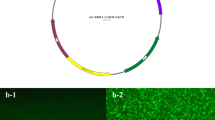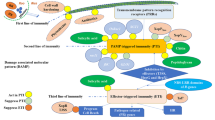Abstract
Endophytic Chaetomium reduced the development of disease caused by Pyrenophora tritici-repentis in wheat leaves. Chaetomium globosum isolate NC-1 and its culture filtrate, applied to leaves 3, 7 and 14 days before inoculation with the pathogen, reduced the development of tan spot in treated leaves of the susceptible cv. Morocco. The disease reduction differed between host cultivars. Disease reduction was more pronounced in cv. Leichhardt than cv. Morocco. Inoculation of the endophyte or its culture filtrate led to accumulation of extracellular proteins in host tissues indicating activation of host defences. The intercellular washing fluid of endophyte-inoculated leaves lacked an inhibitory effect on the pathogen in vitro, and the inhibitory proteinaceous compound produced by the endophyte in vitro was not detected in the intercellular washing fluid of endophyte-infected leaves. The antagonistic effect of the endophyte against the pathogen in planta was probably due to activation of host defences rather than direct antagonism.
Similar content being viewed by others
References
Arnold AE, Mejia LC, Kyllo D, Rojas EI, Maynard Z, et al. (2003) Fungal endophytes limit pathogen damage in a tropical tree. Proceeding of the National Academy of Sciences of the United States of America 100, 15649–15654. doi: 10.1073/pnas.2533483100
Bach EE, Barros BC, Kimati H (2003) Induced resistance against Bipolaris bicolor, Bipolaris sorokiniana and Drechslera triticirepentis in wheat leaves by xantham gum and heat-inactivated conidial suspension. Journal of Phytopathology 151, 411–418. doi: 10.1046/j.1439-0434.2003.00742.x
Bargmann C, Schönbeck F (1992) Acremonium kiliense as inducer of resistance to wilt disease on tomatoes. Zeitschrift fur Pflanzenkrankheiten und Pflanzenschutz 99, 266–272 [Journal of Plant Diseases and Protection].
Benhamou N, Kloepper J, Quadt-Hallman Tuzun S (1996) Induction of defences-related ultrastructural modifications in pea roots tissues inoculated with endophytic bacteria. Plant Physiology 112, 919–929.
Benhamou N, Gagne S, Le Q, Dehbi L (2000) Bacterial-mediated induced resistance in cucumber: Beneficial effect of the endophytic bacterium Serratia plymuthica on the protection against infection by Pythium ultimum. Phytopathology 90, 45–56.
Bowles DJ (1990) Defence-related proteins in higher plants. Annual Review of Biochemistry 59, 873–907. doi: 10.1146/annurev.bi.59.070190.004301
Burpee LL, Bouton JH (1993) Effect of eradication of the endophyte Acremonium coenophialum on epidemics of Rhizoctonia blight in tall fescue. Plant Disease 77, 157–159.
Cabral D, Stone JK, Carroll GC(1993) The internalmycobiota of Juncus spp.: Microscopic and cultural observations of infection patterns. Mycological Research 97, 367–376.
Christensen MJ (1996) Antifungal activity in grasses infected with Acremonium and Epichlo ë endophytes. Australasian Plant Pathology 25, 186–191. doi: 10.1071/AP96032
Clay K (1988) Fungal endophytes of grasses: A defensive mutualism between plants and fungi. Ecology 69, 10–16.
Clay K (1991) Endophytes as antagonists of plant pests. In ‘Microbial ecology of leaves’. (Eds JH Andrews, SS Hirano) pp. 331–357. (Springer-Verlag: New York)
Cordier C, Pozo MJ, Barea JM, Gianinazzi S, Gianinazzi-Pearson V (1998) Cell defence responses associated with localized and systemic resistance to Phytophthora induced in tomato by an arbuscular mycorrhizal fungus. Molecular Plant-Microbe Interactions 11, 1017–1028.
Cromey MG, Cole ALJ (1984) An association between a Lolium endophyte and Drechslera dictyoides. Transactions of British Mycological Society 83, 159–161.
De Wit PJGM, Spikman G (1982) Evidence for the occurrence of race and cultivar-specific elicitors of necrosis in intercellular fluids of compatible interactions of Cladosporium fulvum and tomato. Physiological Plant Pathology 21, 1–11.
Dingle J, McGee PA (2003) Some endophytic fungi reduce the density of pustules of Puccinia recondita f. sp. tritici in wheat. Mycological Research 107, 310–316. doi: 10.1017/S0953756203007512
Gregersen PL, Smedegaard V (1989) Induction of resistance in barley against Erysiphe graminis f. sp. hordei after preinoculation with the saprophytic fungus, Cladosporium macrocarpum. Journal of Phytopathology 124, 128–136.
Heath MC (1980) Reactions of nonsuscepts to fungal pathogens. Annual Review of Phytopathology 18, 211–236. doi: 10.1146/ annurev.py.18.090180.001235
Hume DE, Quigley PE, Aldaoud R (1997) Influence of Neotyphodium infection on plant survival of diseased tall fescue and ryegrass. In ‘Neotyphodium/grass interactions’. (Eds CW Bacon, NS Hill) pp. 171–174. (Plenum Press: New York)
Istifadah N, McGee PA Isolates of endophytic Chaetomium spp. inhibit the fungal pathogen, Pyrenophora tritici-repentis, in vitro. Canadian Journal of Botany, In press.
Laemmli UK (1970) Cleavage of structural proteins during the assembly of the head of bacteriophage T4. Nature 227, 680–685. doi: 10.1038/227680a0
Lane GA, Christensen MJ, Miles CO (2000) Coevolution of fungal endophytes in grasses: the significance of secondary metabolites. In ‘Microbial endophytes’. (Eds CW Bacon, JF White) pp. 341–388. (Marcel Dekker: New York)
van Loon LC (1997) Induced resistance in plants and the role of pathogenesis-related proteins. European Journal of Plant Pathology 103, 753–765. doi: 10.1023/A:1008638109140
Matta A (1971) Microbial penetration and immunization of uncongenial host plants. Annual Review of Phytopathology 9, 387–410. doi: 10.1146/annurev.py.09.090171.002131
Narisawa K, Tokumasu S, Hashiba T (1998) Suppression of clubroot formation in chinese cabbage by the root endophytic fungus, Heteroconium chaetospira. Plant Pathology 47, 206–210. doi: 10.1046/j.1365-3059.1998.00225.x
Narisawa K, Kawamata H, Currah RS, Hashiba T (2002) Suppression of Verticillium wilt in eggplant by some fungal root endophytes. European Journal of Plant Pathology 108, 103–109. doi: 10.1023/A:1015080311041
Narisawa K, Usuki F, Hashiba T (2004) Control of Verticillium yellows in Chinese cabbage by the dark septate endophytic fungus LtVB3. Phytopathology 94, 412–418.
Olson BD (2001) Crop disease and yield loss. In ‘Biotic stress and yield loss’. (Eds RKD Peterson, LG Higley) pp. 185–200. (CRC Press: Boca Raton)
Peters S, Dammeyer B, Schulz B (1998) Endophyte-host interactions. I. Plant defence reactions to endophytic and pathogenic fungi. Symbiosis 25, 193–211.
Petrini O (1991) Fungal endophytes of tree leaves. In ‘Microbial ecology of leaves’. (Eds JH Andrews, SS Hirano) pp. 179–197. (Spring-Verlag: New York)
Postma J, Luttikholt AJG (1996) Colonization of carnation stems by a non-pathogenic isolate of Fusarium oxysporum and its effect on Fusarium oxysporum f. sp. dianthi. Canadian Journal of Botany 74, 1841–1851.
Pozo MJ, Cordier C, Dumas-Gaudot E, Gianinazzi S, Barea JM, et al. (2002) Localized versus systemic effect of arbuscular mycorrhizal fungi on defence responses to Phytophthora infection in tomato plants. Journal of Experimental Botany 53, 525–534. doi: 10.1093/jexbot/53.368.525
Rodriguez RJ, Redman RS, Henson JM (2005) Symbiotic lifestyle expression by fungal endophytes and the adaptation of plants to stress: Unravelling the complexities of intimacy. In ‘The fungal community’. 3rd edn. (Eds J Dighton, JF White, P Oudemans) pp. 683–695. (Taylor and Francis: Boca Raton)
Saikkonen K, Faeth SH, Helander M, Sullivan TJ (1998) Fungal endophytes: a continuum of interactions with host plants. Annual Review of Ecology and Systematics 29, 319–343. doi: 10.1146/annurev.ecolsys.29.1.319
Schönbeck F, Dehne HW (1986) Use of microbial metabolites inducing resistance against plant pathogens. In ‘Microbiology of the phyllosphere’. (Eds NJ Fokkema, J van den Heuvel) pp. 363–375. (Academic Press: New York)
Smith KP, Goodman RM (1999) Host variation for interactions with beneficial plant-associated microbes. Annual Review of Phytopathology 37, 473–491. doi: 10.1146/annurev.phyto.37.1.473
Steiner U, Schönbeck F (1995) Induced disease resistance in monocots. In ‘Induced resistance to disease in plants’. (Eds R Hammerschimdt, J Kuc) pp. 86–110. (Kluwer Academic: Dordrecht)
Sticher L, Mauch-Mani B, Metraux JP (1997) Systemic Acquired Resistance. Annual Review of Phytopathology 35, 235–270. doi: 10.1146/annurev.phyto.35.1.235
Suo Y, Leung DWM (2002) BTH-induced accumulation of extracellular proteins and black spot disease in rose. Biologia Plantarum 45, 273–279. doi: 10.1023/A:1015161110058
Vilich V, Dolfen M, Sikora RA (1998) Chaetomium spp. colonization of barley following seed treatment and its effect on plant growth and Erysiphe graminis f. sp. hordei disease severity. Zeitschrift fur Pflanzenkrankheiten und Pflanzenschutz 105, 130–139 [Journal of Plant Diseases and Protection].
Welty RE, Barker RE, Azevedo MD (1991) Reaction of tall fescue infected and non-infected by Acremonium coenophialum to Puccinia graminis subsp. graminicola. Plant Disease 75, 883–886.
Wennstrom A (1994) Endophyte, misuse of an old term. Oikos 73, 535–536.
van der Westhuizen AJ, Qian X-M, Botha A-M (1998) β-1,3-glucanase in wheat and resistance to the Russian wheat aphid. Physiologia Plantarum 103, 125–131. doi: 10.1034/j.1399-3054.1998.1030115.x
Wilson D (1995) Endophyte: The evolution of term, and clarification of its use and definition. Oikos 73, 274–276.
Wilson D (2000) Ecology of woody plant endophytes. In ‘Microbial endophytes’. (Eds CW Bacon, JF White) pp. 389–420. (Marcel Dekker: New York)
Zidack NK, Backman PA, Shaw JJ (1992) Promotion of bacterial infection of leaves by an organosilicone surfactant: Implications for biological weed control. Biological Control 2, 111–117. doi: 10.1016/1049-9644(92)90034-B
Author information
Authors and Affiliations
Corresponding author
Rights and permissions
About this article
Cite this article
Istifadah, N., McGee, P.A. Endophytic Chaetomium globosum reduces development of tan spot in wheat caused by Pyrenophora tritici-repentis . Australasian Plant Pathology 35, 411–418 (2006). https://doi.org/10.1071/AP06038
Received:
Accepted:
Issue Date:
DOI: https://doi.org/10.1071/AP06038




